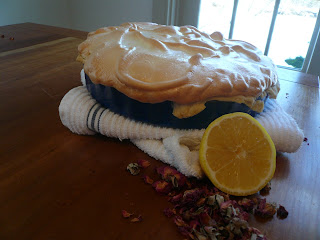 Every February, I make a lemon meringue pie for my husband's birthday. It is his favorite food in the whole world, not mine. But since he is my favorite person in the whole world, I make it anyway. And I'll fill you in on a little secret which even he doesn't know--I have serious issues with that meringue. I'll talk about that later, but first I want to touch on a new twist I tried this year, steeping rose petals into the lemon curd. It's a perfect Valentine's Day touch if you want a relief from chocolate, and a heart-warming reminder that winter doesn't last forever.
Every February, I make a lemon meringue pie for my husband's birthday. It is his favorite food in the whole world, not mine. But since he is my favorite person in the whole world, I make it anyway. And I'll fill you in on a little secret which even he doesn't know--I have serious issues with that meringue. I'll talk about that later, but first I want to touch on a new twist I tried this year, steeping rose petals into the lemon curd. It's a perfect Valentine's Day touch if you want a relief from chocolate, and a heart-warming reminder that winter doesn't last forever.I will tell you without shame, that I try to find a way to put rose petals into almost every lemon thing, as the two flavors together are sublime. In this case, it was a match made in heaven. I loved it, and it has succeeded in turning one of his favorites into one of mine.
But that pesky meringue...I'm not a big fan. I don't like the height, or the texture of all that fluff. And often it comes out runny. You can try avoiding that by making sure it touches the crust all around, cooking the meringue well past it's prime. Most importantly, let the pie cool to room temperature before refrigerating it, and you may have luck. I decided this time to do more of a Swiss meringue, which is cooked a little before putting on the pie. It was an improvement, although some may not like the relaxed look of the finish.
I was going for an 'artisan' look this time, with a barely trimmed crust and straight-up sides instead of the traditional slope-sided crust with perfectly primped edges, so I was fine with the more relaxed look. The Swiss meringue offered a much more appetizing finish to the pie tasting almost like a marshmallow topping. Next time, I will try an Italian meringue, which will be less dense and perhaps more suited to this kind of pie. If it works, I'll give the full complicated instructions.
For the pie below however, I'm giving you the most basic French meringue technique, hoping you'll have better luck at the stuff than I do. It's really all about the fantastic lemon curd anyway!
Make your favorite basic single crust and blind bake it. (I use a mixture of rice and beans for blind-baking so they don't ever get used for another recipe by accident.) Work on the filling while the crust is baking. And when the crust comes out, keep the oven at 350°F.
 Filling:
Filling:1 1/2 cups whole milk (divided)
1/4 cup food-grade dried rose petals
4 large egg yolks
1 cup sugar
4 1/2 tablespoons cornstarch
1/4 teaspoon salt
1 cup water
1 tablespoon unsalted butter
2 teaspoons finely grated lemon zest
1/2 cup fresh lemon juice
Meringue:
6 large egg whites
1/2 teaspoon cream of tartar
1/4 teaspoon salt
3/4 cup sugar
Warm 1 cup milk until steaming and too hot to touch. Remove from heat, add the rose petals, cover and let steep until ready to use. Strain out the petals before using.
Whisk together the eggs in a bowl. Combine and whisk the sugar, cornstarch and salt in a large saucepan. Gradually add water and remaining 1/2 cup milk, whisking until cornstarch is dissolved. Bring to a boil over moderate heat, whisking until mixture begins to thicken. Temper* in the eggs, then the strained rose-milk. Simmer, whisking for 3 minutes.
Remove from heat and and whisk in butter, zest, and juice until butter is melted and filling is smooth. (An extra-careful step here, pour the mixture through a strainer to keep the curd smooth.) Cover with parchment to keep warm while you make the meringue.
Beat egg-whites, cream of tartar, and salt in a large bowl (copper, if you have it) until they hold soft peaks. Slowly beat in sugar, 1 tablespoon at a time, and continue to beat until meringue just holds stiff peaks.
Pour filling into the warm shell. Spread meringue on top to very edge of pastry. Make it all pretty with swirls and peaks. Bake until meringue is golden, about 15 minutes. Cool to room temperature for 2 hours, then refrigerate for another 2 hours before serving.
* To temper, add some of the hot mixture to the egg, whisking thoroughly, then pour the egg into the remaining hot mixture, whisking thoroughly. This helps to prevent overcooking the eggs.
**This recipe is adapted from The Gourmet Cookbook. God love you, Ruth Reichl!

Having recently made my very first lemon tarte (curd without the meringue) I'm now inspired to try again, using your rose petal trick. Know a local source for rose petals, Marcia? Wonderful posts!
ReplyDelete